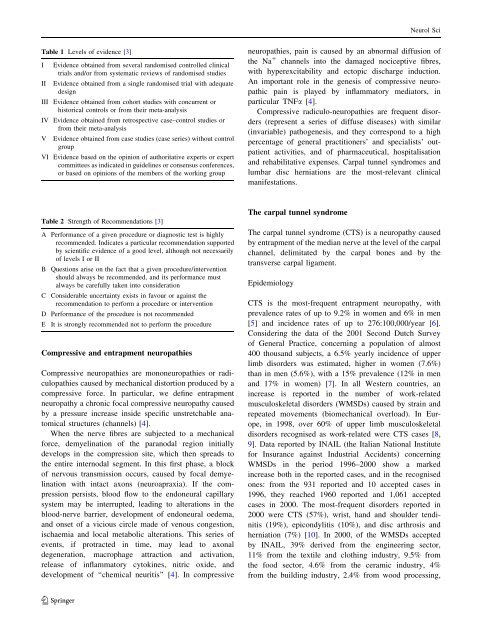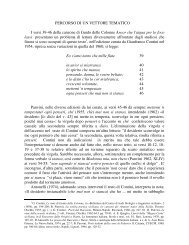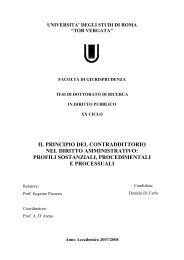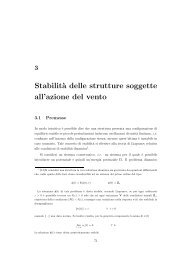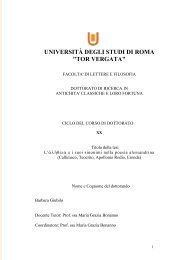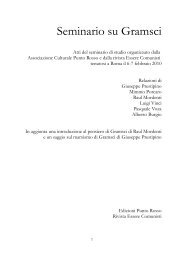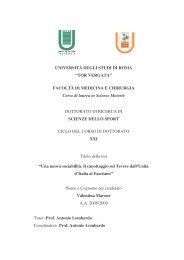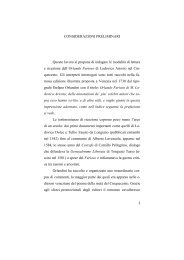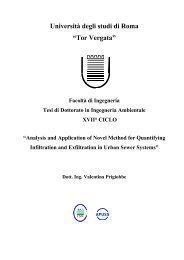Diagnosis, treatment and follow-up of the carpal ... - Home page | ART
Diagnosis, treatment and follow-up of the carpal ... - Home page | ART
Diagnosis, treatment and follow-up of the carpal ... - Home page | ART
Create successful ePaper yourself
Turn your PDF publications into a flip-book with our unique Google optimized e-Paper software.
Table 1 Levels <strong>of</strong> evidence [3]<br />
I Evidence obtained from several r<strong>and</strong>omised controlled clinical<br />
trials <strong>and</strong>/or from systematic reviews <strong>of</strong> r<strong>and</strong>omised studies<br />
II Evidence obtained from a single r<strong>and</strong>omised trial with adequate<br />
design<br />
III Evidence obtained from cohort studies with concurrent or<br />
historical controls or from <strong>the</strong>ir meta-analysis<br />
IV Evidence obtained from retrospective case–control studies or<br />
from <strong>the</strong>ir meta-analysis<br />
V Evidence obtained from case studies (case series) without control<br />
gro<strong>up</strong><br />
VI Evidence based on <strong>the</strong> opinion <strong>of</strong> authoritative experts or expert<br />
committees as indicated in guidelines or consensus conferences,<br />
or based on opinions <strong>of</strong> <strong>the</strong> members <strong>of</strong> <strong>the</strong> working gro<strong>up</strong><br />
Table 2 Strength <strong>of</strong> Recommendations [3]<br />
A Performance <strong>of</strong> a given procedure or diagnostic test is highly<br />
recommended. Indicates a particular recommendation s<strong>up</strong>ported<br />
by scientific evidence <strong>of</strong> a good level, although not necessarily<br />
<strong>of</strong> levels I or II<br />
B Questions arise on <strong>the</strong> fact that a given procedure/intervention<br />
should always be recommended, <strong>and</strong> its performance must<br />
always be carefully taken into consideration<br />
C Considerable uncertainty exists in favour or against <strong>the</strong><br />
recommendation to perform a procedure or intervention<br />
D Performance <strong>of</strong> <strong>the</strong> procedure is not recommended<br />
E It is strongly recommended not to perform <strong>the</strong> procedure<br />
Compressive <strong>and</strong> entrapment neuropathies<br />
Compressive neuropathies are mononeuropathies or radiculopathies<br />
caused by mechanical distortion produced by a<br />
compressive force. In particular, we define entrapment<br />
neuropathy a chronic focal compressive neuropathy caused<br />
by a pressure increase inside specific unstretchable anatomical<br />
structures (channels) [4].<br />
When <strong>the</strong> nerve fibres are subjected to a mechanical<br />
force, demyelination <strong>of</strong> <strong>the</strong> paranodal region initially<br />
develops in <strong>the</strong> compression site, which <strong>the</strong>n spreads to<br />
<strong>the</strong> entire internodal segment. In this first phase, a block<br />
<strong>of</strong> nervous transmission occurs, caused by focal demyelination<br />
with intact axons (neuroapraxia). If <strong>the</strong> compression<br />
persists, blood flow to <strong>the</strong> endoneural capillary<br />
system may be interr<strong>up</strong>ted, leading to alterations in <strong>the</strong><br />
blood-nerve barrier, development <strong>of</strong> endoneural oedema,<br />
<strong>and</strong> onset <strong>of</strong> a vicious circle made <strong>of</strong> venous congestion,<br />
ischaemia <strong>and</strong> local metabolic alterations. This series <strong>of</strong><br />
events, if protracted in time, may lead to axonal<br />
degeneration, macrophage attraction <strong>and</strong> activation,<br />
release <strong>of</strong> inflammatory cytokines, nitric oxide, <strong>and</strong><br />
development <strong>of</strong> ‘‘chemical neuritis’’ [4]. In compressive<br />
123<br />
neuropathies, pain is caused by an abnormal diffusion <strong>of</strong><br />
<strong>the</strong> Na ? channels into <strong>the</strong> damaged nociceptive fibres,<br />
with hyperexcitability <strong>and</strong> ectopic discharge induction.<br />
An important role in <strong>the</strong> genesis <strong>of</strong> compressive neuropathic<br />
pain is played by inflammatory mediators, in<br />
particular TNFa [4].<br />
Compressive radiculo-neuropathies are frequent disorders<br />
(represent a series <strong>of</strong> diffuse diseases) with similar<br />
(invariable) pathogenesis, <strong>and</strong> <strong>the</strong>y correspond to a high<br />
percentage <strong>of</strong> general practitioners’ <strong>and</strong> specialists’ outpatient<br />
activities, <strong>and</strong> <strong>of</strong> pharmaceutical, hospitalisation<br />
<strong>and</strong> rehabilitative expenses. Carpal tunnel syndromes <strong>and</strong><br />
lumbar disc herniations are <strong>the</strong> most-relevant clinical<br />
manifestations.<br />
The <strong>carpal</strong> tunnel syndrome<br />
The <strong>carpal</strong> tunnel syndrome (CTS) is a neuropathy caused<br />
by entrapment <strong>of</strong> <strong>the</strong> median nerve at <strong>the</strong> level <strong>of</strong> <strong>the</strong> <strong>carpal</strong><br />
channel, delimitated by <strong>the</strong> <strong>carpal</strong> bones <strong>and</strong> by <strong>the</strong><br />
transverse <strong>carpal</strong> ligament.<br />
Epidemiology<br />
Neurol Sci<br />
CTS is <strong>the</strong> most-frequent entrapment neuropathy, with<br />
prevalence rates <strong>of</strong> <strong>up</strong> to 9.2% in women <strong>and</strong> 6% in men<br />
[5] <strong>and</strong> incidence rates <strong>of</strong> <strong>up</strong> to 276:100,000/year [6].<br />
Considering <strong>the</strong> data <strong>of</strong> <strong>the</strong> 2001 Second Dutch Survey<br />
<strong>of</strong> General Practice, concerning a population <strong>of</strong> almost<br />
400 thous<strong>and</strong> subjects, a 6.5% yearly incidence <strong>of</strong> <strong>up</strong>per<br />
limb disorders was estimated, higher in women (7.6%)<br />
than in men (5.6%), with a 15% prevalence (12% in men<br />
<strong>and</strong> 17% in women) [7]. In all Western countries, an<br />
increase is reported in <strong>the</strong> number <strong>of</strong> work-related<br />
musculoskeletal disorders (WMSDs) caused by strain <strong>and</strong><br />
repeated movements (biomechanical overload). In Europe,<br />
in 1998, over 60% <strong>of</strong> <strong>up</strong>per limb musculoskeletal<br />
disorders recognised as work-related were CTS cases [8,<br />
9]. Data reported by INAIL (<strong>the</strong> Italian National Institute<br />
for Insurance against Industrial Accidents) concerning<br />
WMSDs in <strong>the</strong> period 1996–2000 show a marked<br />
increase both in <strong>the</strong> reported cases, <strong>and</strong> in <strong>the</strong> recognised<br />
ones: from <strong>the</strong> 931 reported <strong>and</strong> 10 accepted cases in<br />
1996, <strong>the</strong>y reached 1960 reported <strong>and</strong> 1,061 accepted<br />
cases in 2000. The most-frequent disorders reported in<br />
2000 were CTS (57%), wrist, h<strong>and</strong> <strong>and</strong> shoulder tendinitis<br />
(19%), epicondylitis (10%), <strong>and</strong> disc arthrosis <strong>and</strong><br />
herniation (7%) [10]. In 2000, <strong>of</strong> <strong>the</strong> WMSDs accepted<br />
by INAIL, 39% derived from <strong>the</strong> engineering sector,<br />
11% from <strong>the</strong> textile <strong>and</strong> clothing industry, 9.5% from<br />
<strong>the</strong> food sector, 4.6% from <strong>the</strong> ceramic industry, 4%<br />
from <strong>the</strong> building industry, 2.4% from wood processing,


